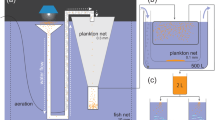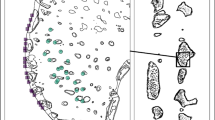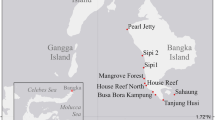Abstract
In order to understand the reproductive ecology of coral-reef fishes, fecundity which is the physiological maximum potential reproductive output, was examined in eleven families of coral-reef fishes in the east coast of Peninsula Malaysia. Three families, Pomacentridae, Monodactylidae and Chaetodontidae, with five species, Amphiprion ocellaris, Amphiprion perideraion, Abudefduf bengalensis, Monodactylus argenteus and Chaetodon octofasciatus, could collect female specimens, while all specimens were male in eight out of eleven families with sixteen species. Mean fecundities ranged from 693 to 122,247 with the lowest fecundity was found in Pomacentridae, and Chaetodontidae had the highest fecundity. Amphiprion ocellaris and A. perideraion practice parental care with demersal spawners, and such unique reproductive ecology might produce lower number of eggs to be able to increase their reproductive success compared to other coral reef fishes spawned pelagic eggs. This study provides an insight of baseline knowledge of the reproductive biology of coral-reef fishes for future studies of important fish species in coral ecosystem.

Similar content being viewed by others
References
Abdul Khadir SA, Yamin L, Arai T (2017) Fecundity of the tropical catadromous eels Anguilla bicolor bicolor, A. bengalensis bengalensis and A. marmorata. Environ Biol Fish 100:1643–1648
Agustin LQ (2016) Amphiprion ocellaris, Clown anemonefish. Retrieved April 23, 2016, from http://www.fishbase.org/summary/6509
Ajith Kumar T, Balasubramanian T (2009) Broodstock development, spawning and larval rearing of the flase clown fish, Amphiprion ocellaris in captivity using estuarine water. Curr Sci 97:1483–1486
Alava VR, Gomes LAO (1989) Breeding marine aquarium animals: the Anemonefish. Naga Iclarm Q 12:12–13
Allen GR (1972) The anemonefish: their classification and biology, 1st edn. T.F.H. Publications, Neptune City
Amalina R, Bachok Z, Arai T (2016) Influence of growth on fatty acid composition of the moon wrasse Thalassoma lunare collected in coral reef habitats of the Malaysian South China Sea. Trop Ecol 57:779–785
Anand PV, Pillai N (2002) Reproductive biology of some common coral reef fishes of the Indian EEZ. Biol Assoc India 44:122–135
Arai T (2014) Diversity and conservation of coral reef fieshes in Malaysian South China Sea. Rev Fish Biol Fish 25:1–17
Arai T, Amalina R, Bachok Z (2015a) Similarity in the feeding ecology of parrotfish (Scaridae) in coral reef habitats of the Malaysian South China Sea, as revealed by fatty acid signatures. Biochem Syst Ecol 59:85–90
Arai T, Amalina R, Bachok Z (2015b) Growth effect on liver fatty acid composition of damselfishes genus Abudefduf collected in coral reef habitats of the Malaysian South China Sea. SpringerPlus 4:71
Arai T, Amalina R, Bachok Z (2015c) Fatty acid composition indicating diverse habitat use in coral reef fishes in the Malaysian South China Sea. Biol Res 48:13
Armstrong MJ, Witthames PR (2012) Development in understanding of fecundity of fish stocks in relation to egg production methods for estimating spawning stock biomass. Fish Res 117–118:35–47
Bell LJ (1976) Notes on the Nesting Success and Fecundity of the Anemonefish Amphiprion clarkii at Miyake-Jima, Japan. Jpn J Ichthyol 22:207–211
Biondo MV (2017) Quantifying the trade in marine ornamental fishes into Switzerland and an estimation of imports from the European Union. Glob Ecol Conserv 11:95–105
Biswas A, Ghosh S (2015) Estimation of fecundity. Jessore University of Science and Technology, Jessore
Bshary R (2003) The cleaner wrasse, Labroides dimidiatus, is a key organism for reef fish diversity at Ras Mohammed National Park. Egypt J Anim Ecol 72:169–176
Cato JC (2003) Marine ornamental species: collection, culture and conservation. Blackwell Publishing, Hoboken
Chong VC, Lee PKY, Lau CM (2010) Diversity, extinction risk and conservation of Malaysian fishes. J Fish Biol 76:2009–2066
Cuellar N, Sedberry GR, Wyanski DM (1996) Reproductive seasonality, maturation, fecundity, and spawning frequency of the vermilion snapper, Rhomboplites aurorubens, off the southeastern United States. Fish Bull 94:635–653
DeMartini EE, Sikkel PC (2006) Reproduction. In: Allen LG, Pondela DS, Horn MH (eds) The ecology of marine fishes: California and adjacent waters. University of California Press, Berkeley, pp 483–523
Dominguez LM, Botella ÁS (2014) An overview of marine ornamental fish breeding as a potential support to the aquarium trade and to the conservation of natural fish population. Int J Sustain Dev Plan 9:608–632
Duarte CM, Alcaraz M (1989) To produce many small or few large eggs: a size-independent reproductive tactic of fish. Oecologia 80:401–404
Fitzhugh GR, Shertzer KW, Kellison GT, Wyanski DM (2012) Review of size- and age-dependence in batch spawning: implications for stock assessment of fish species exhibiting indeterminate fecundity. Fish Bull 110:413–425
Fotedar RK, Phillips BF (2011) Recent advances and new species in aquaculture. Wiley-Blackwell, Hoboken
Ganias K, Murua H, Claramunt G, Dominguez-Petit R, Gonalves P, Juanes F et al (2014) Chapter 4: Egg production. In: Dominguez-Petit R, Murua H, Saborido-Rey F, Trippel E (eds) Handbook of applied fisheries reproductive biology for stock assessment and management. Digital CSIC, Vigo
Kraus G, Tomkiewicz J, Koster FW (2002) Egg production of Baltic cod (Gadus morhua) in relation to variable sex ratio, maturity, and fecundity. Can J Fish Aquat Sci 59:1908–1920
Krishnakumar PK (2017) The economic times. Retrieved from https://economictimes.indiatimes.com/industry/consproducts/food/ornamental-fish-industry-hit-by-new-regulations/articleshow/59174671.cms
Lambert Y (2008) Why should we closely monitor fecundity in marine fish populations? J Northwest Atl Fish Sci 41:93–106
Lowerre-Barbieri SK, Ganias K, Saborido-Rey F, Murua H, Hunter JR (2011) Reproductive timing in marine fishes: variability, temporal scales, and methods. Mar Coast Fish 3:71–91
Lowerre-Barbierri SK (2009) Reproduction in relation to conservation and exploitation of marine fishes. In: Jamieson BGM (ed) Reproductive biology and phylogeny of fishes (Agnathans and Bony Fishes). CRC Press, Durham, pp 371–394
Maduppa HH, Juterzenka KV, Syakir M, Kochzius M (2014) Socio-economy of marine ornamental fishery and its impact on the population structure of the clown anemonefish Amphiprion ocellaris and its host anemones in Spermonde Archipelago, Indonesia. Ocean Coas Manag 100:41–50
Matsunuma M, Motomura H, Matsuura K, Shazili NAM, Ambak MA (2011) Fishes of Terengganu: east coast of Malay Peninsula, Malaysia. Universiti Malaysia Terengganu and Kagoshima University Museum. National Museum of Nature and Science
McElroy WD, Wuenschel MJ, Towle EK, McBride RS (2016) Spatial and annual variation in fecundity and oocyte atresia of yellowtail flounder, Limanda ferruginea, in U.S. waters. J Sea Res 107:76–89
Mertz G, Myers RA (1996) Influence of fecundity on recruitment variability of marine fish. Can J Fish Aquat Sci 53:1618–1625
Murua H, Saborido-Rey F (2003) Female reproductive strategies of marine fish species of the North Atlantic. Northwest Atl Fish Sci 33:23–31
Murua H, Kraus G, Saborido-Rey F, Witthames PR, Thorsen A, Junquera S (2003) Procedures to estimate fecundity of marine fishes species in relation to their reproductive strategy. J Northwest Atl Fish Sci 33:33–54
Ochi H (1985) Temporal patterns of breeding and larval settlement in a temperate population of the tropical anemonefish, Amphiprion clarkii. Ichthyol Res 32:248–257
Ochi H (1989) Mating behaviour and sex change of the anemonefish, Amphiprion clarkii, in the temperate waters of Japan. Environ Biol Fish 26:257–275
Perrone M, Zaret T (1979) Parental care patterns of fishes. Am Nat 113:351–361
Priyadharsin S, Manoharan J, Varadharajan D, Subramaniyam A (2013) Reproduction biology and histology study of red lionfish Pterois volitans from Cuddalore, South East Coast of India. J Aquacult Res Dev 4:201
Rainer F (2016) Amphiprion perideraion, Pink anemonefish. Retrieved from http://www.fishbase.org/summary/Amphiprion-perideraion.html
Reksodihardjo-Lilley G, Lilley R (2007) Towards a sustainable marine aquarium trade: an Indonesia perspective. SPC Live Reef Fish Inf Bull 17:11–19
Rhyne AL, Tlusty MF, Szczebak JT, Holmberg RJ (2017) Expanding our understanding of the trade in marine aquarium animals. Peer J. https://doi.org/10.7717/peerj.2949
Richardson DL, Harrison PL, Harriott VJ (1997) Timing of spawning and fecundity of a tropical and subtropical anemonefish (Pomacentridae: Amphiprion) on a high latitude reef on the east coast of Australia. Mar Ecol Prog Ser 156:175–181
Ross RM (1978) Reproductive behaviour of the anemonefish Amphiprion melanopus on Guam. Copeia 1978:103–107
Sadovy YJ (1996) Reproduction of reef fishery species. In: Polunin NVC, Roberts CM (eds) Reef fishes. Chapman & Hall, New York, pp 15–59
Sadovy Y, Mitcheson G, Rasotto M (2001) Early development of the mandarinfish Synchiropus splendidus (Callionymidae), with notes on its fishery and potential culture. Aquar Sci Conserv 3:253–263
Sale PF (1990) Recruitment of marine species: is the bandwagon rolling in the right direction? Trends Ecol Evol 5:25–27
Shuman CS, Hodgson G, Ambrose RF (2005) Population impacts of collecting sea anemones and anemonefish for the marine aquarium trade in the Philippines. Coral Reefs 24:564–573
Sokal RR, Rofhl FJ (1995) Biometry. The principles and practice of statistics in biological research, 3rd edn. WH Freeman, New York
Syafrina AH, Zalina MD, Juneng L (2015) Historical trend of hourly extreme rainfall in Peninsula Malaysia. Theoret Appl Climatol 120:259–285
Tan IV, Arai T (2019) Reproductive characteristics of the anemonefishes Amphiprion ocellaris and A. perideraion in east coast of Peninsula Malaysia, Malaysia. Vie et Milieu 69:107–111
Tissot BN, Best BA, Borneman EH, Bruckner AW, Cooper CH, D’Agnes H, Fitzgerald TP, Leland A, Lieberman S, Amos AM, Sumaila R, Telecky TM, McGilvray F, Plankis BJ, Rhyne AL, Roberts GG, Starkhouse B, Stevenson TC (2010) How US ocean policy and market power can reform the coral reef wildlife trade. Mar Policy 34:1385–1388
Tomkiewicz J, Morgan M, Burnett J, Saborido-Rey F (2003) Available information for estimating reproductive potential of Northwest Atlantic groundfish stocks. J Northwest Atl Fish Sci 33:1–22
Vagelli AA (2011) The Banggai Cardinalfish. Natural history, conservation and culture of Pterapogon kauderni. Wiley-Blackwell, Hoboken
Wabnitz C, Taylor M, Green E, Razak T (2003) From Ocean to Aquarium: the global trade in marine ornamental species. UNEP-WCMC, Cambridge
Warner RR (1991) The use of phenotypic plasticity in coral reef fishes as tests of theory in evolutionary ecology. In: Sale PF (ed) The ecology of fisheson coral reefs. Academic Press Inc, California, pp 387–398
Wood E (2001) Global advances in conservation and management of marine ornamental resources. Aquar Sci Conserv 3:65–77
Author information
Authors and Affiliations
Corresponding author
Rights and permissions
About this article
Cite this article
Tan, I.V., Arai, T. Reproductive characteristics of coral-reef fishes, Pomacentridae, Monodactylidae and Chaetodontidae, in the east coast of Peninsula Malaysia. Trop Ecol 60, 532–538 (2019). https://doi.org/10.1007/s42965-020-00055-z
Received:
Revised:
Accepted:
Published:
Issue Date:
DOI: https://doi.org/10.1007/s42965-020-00055-z




